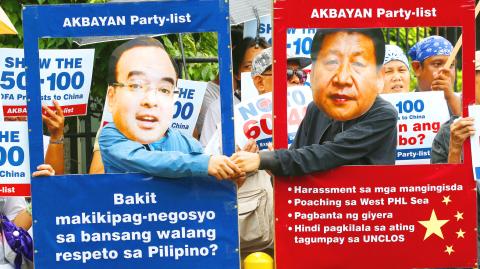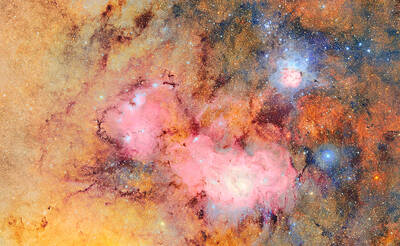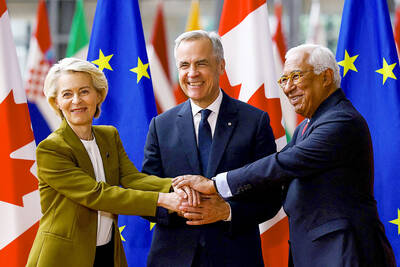China’s giant state-owned enterprises (SOEs) are playing an increasing role in Beijing’s buildup in the South China Sea and could seek to cement their dominant position in coming years, new research shows.
The work by academic Gong Xue (龔雪) and published this week by Singapore’s ISEAS Yusof Ishak Institute sheds light on a little-examined element of rising tensions across the vital trade route, showing extensive work by Chinese SOEs in developing infrastructure and tourism, as well as oil and gas, some in hotly disputed areas.
Some experts and regional diplomats believe the strong commercial presence could further complicate any future regional solution should Beijing, which research shows has encouraged firms to operate, protect them politically and militarily.

Photo: AP
Chinese SOEs operated in a complex and often opaque environment, serving national strategic interests as they sought new opportunities, Gong said.
“They cannot operate independently, but they are ultimately opportunists and when the policy environment is favorable, then they will go for it. And we have seen signs of that behavior in the South China Sea,” said Gong, who is based at Singapore’s Nanyang Technological University’s S. Rajaratnam School of International Studies.
“If the Chinese government can maintain an upper hand and leverage while achieving stability, there might well be greater opportunities,” she said.
The Chinese Ministry of Foreign Affairs said there was nothing wrong with Chinese firms carrying out of “normal commercial activities” on Chinese territory.
“The Chinese government manages and regulates Chinese companies in accordance with the law,” the ministry said in a statement.
While the research notes the difficulty in obtaining financial information, it suggests turning China’s seven reefs and cays in the Spratlys archipelago (Nansha Islands, 南沙群島) — which Taiwan also claims — into manmade islands was a multibillion-dollar effort.
It cites state media estimates that building up Fiery Cross Reef (Yongshu Reef, 永暑島) alone, now home to a 3km runway and military facilities, including missile and radar installations, cost about US$11 billion.
The ongoing buildup of the seven islands deep in the maritime heart of Southeast Asia has alarmed the US and other regional powers.
China’s so-called “nine-dash line” claim covers much of the South China Sea, overlapping claims of Taiwan, Vietnam, the Philippines, Malaysia and Brunei.
Gong’s research shows how China Communications Construction Corp (CCCC) and its subsidiaries seized on policies advocated by Chinese President Xi Jinping (習近平) in 2012 to expand its maritime capabilities via the South China Sea, in part by developing some of the world’s largest dredgers.
CCCC planned to list its dredging operation in 2015, but its application later lapsed, according to the Hong Kong Stock Exchange.
The company has formed new units centered on the Paracel Islands (Xisha Islands, 西沙群島), which Taiwan and Vietnam also claim, that are eyeing expansion in tourism, logistics, fishing, as well as ongoing construction business, according to the paper.
It has earmarked US$15 billion for investment across various sectors — a plan that “stems from the fact that it has quietly benefited from land reclamation in the South China Sea through implementing national tasks,” the research states.
CCCC also collaborated with other SOEs, including China Travel Service Group (CTSG), to develop a nascent cruise ship and tourism industry in the Paracels after state leaders in 2012 overcame earlier reluctance to back such moves.
CCCC, which has units listed in Hong Kong and Shanghai, did not respond to requests for comment.
China National Travel Service, which oversees CTSG after a series of mergers, did not respond to requests for comment.
More than 70,000 tourists have traveled on four cruise ships that ply the South China Sea since the Paracels route was opened in April 2013, the Hainan Maritime Safety Administration said in January.
About 680 commercial flights landed on the expanded runway at Woody Island (Yongxing Island, 永興島), where Sansha City is now the administrative hub of China’s South China Sea operations.
The study also details how China National Offshore Oil Corp (CNOOC) lobbied for funding and greater Chinese involvement in the South China a decade ago after facing criticism from academics concerned at activities by rival claimants.
CNOOC earmarked US$32 billion for exploration and built a giant deep water drilling rig, which was placed off central Vietnam in 2014, sparking tensions with Hanoi.
According to its first quarter filings of listed unit CNOOC Ltd, which is in charge of all the group’s exploration and production business, the South China Sea’s share of the company’s total oil and gas output rose to 45 percent — up from 43 percent last year.
That was second only to its Bohai operations off north China.
CNOOC’s latest annual report listed eight new discoveries in the South China Sea, out of a total of 19 struck offshore China last year.
Some players like CNOOC “appear more skilful and effective in mobilizing resources to influence state policy, while some actors, such as enterprises in the tourism industry, respond only when the state provides incentives,” Gong wrote.
In a statement to Reuters, CNOOC Ltd said it had a deep water development strategy for the South China Sea and planned to extend investment on future exploration and development.
“All oil and gas companies among the globe are welcomed to jointly invest and operate in offshore China and to achieve success together with the company,” CNOOC Ltd said.
A host of other state firms are reportedly eyeing slices of the South China Sea action, from nascent nuclear energy programs, telecommunications, fisheries and banking.
Ian Storey, a South China Sea expert at ISEAS, said the work showed “Beijing is incentivizing companies to become major players in the South China Sea.”
“This is something that China can do that the other claimants cannot do, particularly on this scale,” he said.
“The dispute is absolutely no closer to resolution, either a legal or a political resolution, and the role of China’s state owned enterprises only highlights that,” he said.

The team behind the long-awaited Vera Rubin Observatory in Chile yesterday published their first images, revealing breathtaking views of star-forming regions as well as distant galaxies. More than two decades in the making, the giant US-funded telescope sits perched at the summit of Cerro Pachon in central Chile, where dark skies and dry air provide ideal conditions for observing the cosmos. One of the debut images is a composite of 678 exposures taken over just seven hours, capturing the Trifid Nebula and the Lagoon Nebula — both several thousand light-years from Earth — glowing in vivid pinks against orange-red backdrops. The new image

Canada and the EU on Monday signed a defense and security pact as the transatlantic partners seek to better confront Russia, with worries over Washington’s reliability under US President Donald Trump. The deal was announced after a summit in Brussels between Canadian Prime Minister Mark Carney and European Commission President Ursula von der Leyen and European Council President Antonio Costa. “While NATO remains the cornerstone of our collective defense, this partnership will allow us to strengthen our preparedness ... to invest more and to invest smarter,” Costa told a news conference. “It opens new opportunities for companies on both sides of the

ESPIONAGE: The British government’s decision on the proposed embassy hinges on the security of underground data cables, a former diplomat has said A US intervention over China’s proposed new embassy in London has thrown a potential resolution “up in the air,” campaigners have said, amid concerns over the site’s proximity to a sensitive hub of critical communication cables. The furor over a new “super-embassy” on the edge of London’s financial district was reignited last week when the White House said it was “deeply concerned” over potential Chinese access to “the sensitive communications of one of our closest allies.” The Dutch parliament has also raised concerns about Beijing’s ideal location of Royal Mint Court, on the edge of the City of London, which has so

OVERHAUL: The move would likely mark the end to Voice of America, which was founded in 1942 to counter Nazi propaganda and operated in nearly 50 languages The parent agency of Voice of America (VOA) on Friday said it had issued termination notices to more than 639 more staff, completing an 85 percent decrease in personnel since March and effectively spelling the end of a broadcasting network founded to counter Nazi propaganda. US Agency for Global Media (USAGM) senior advisor Kari Lake said the staff reduction meant 1,400 positions had been eliminated as part of US President Donald Trump’s agenda to cut staffing at the agency to a statutory minimum. “Reduction in Force Termination Notices were sent to 639 employees at USAGM and Voice of America, part of a